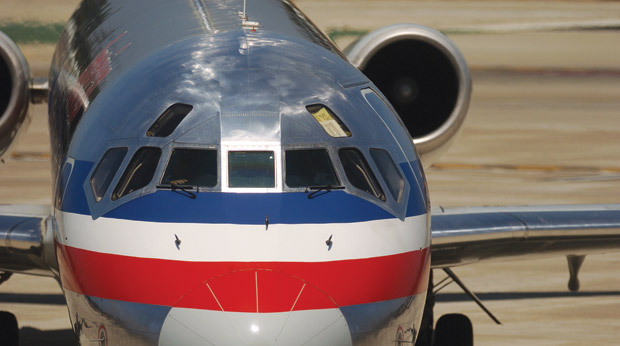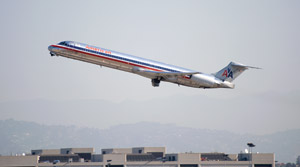News | Regional News
Taking off for good: Students, businesses prepare for American Airlines to cut flights to Lambert Airport

American Airlines flight 1220 to Lambert - St. Louis International Airport pushes back from the gate at San Diego International Airport over the summer. San Diego is one of 7 cities losing service to and from St. Louis on American Airlines by the end of November. American is slashing flights at Lambert as it removes the airport’s hub designation. (Matt Mitgang | Student Life)
Students are bracing for sweeping flight cuts by American Airlines at Lambert-St. Louis International Airport as the already struggling local business community prepares to take a hit.
The cuts, which will occur in phases through April 2010, will leave students from 15 cities with no nonstop service from Lambert, unless other airlines backfill those routes.
“It’s a shame for them to cut out that service,” said junior Peter Murrey of Nashville, Tenn., which will lose all American Airlines service from St. Louis in April and not be served by any other airlines. “It’s not that bad of a drive, but the choices are you can drive your car back home or you can take the Greyhound—which isn’t exactly the most fun in the world, so options are severely limited.”
Local leaders and analysts have raised concerns that the cuts will cause the region to become less accessible, slowing long-term economic growth and discouraging companies from coming to the area.
In June, American Airlines initially announced flight cuts to 10 cities, three of which will not be served by any other airlines. But on Sept. 17, the airline announced it would cut 46 more flights, end service to 20 cities and drop St. Louis as a hub. American Airlines was the last major airline with a hub in the city.
American spokesman Tim Smith said the airline is making the cuts because parent company AMR is restructuring. The airline, he said, is adding flights to more profitable markets, including its hubs in major cities, and cutting back where it cannot break even.

An American Airlines McDonnell Douglas (Boeing) MD-80 departs Los Angeles International Airport. American Airlines, currently the number one airline in St. Louis by number of destinations served, is slashing numerous flights to and from its St. Louis hub in November. (Matt Mitgang | Student Life)
Lambert officials are talking to airlines in the hope that some will backfill the routes American is cutting, airport spokesman Jeff Lea said last week. While it’s still unclear if airlines will respond due to low demand in the recession, officials were confident that at least some would, because there is still demand for the routes being cut—many of which serve major cities like San Diego, San Francisco, Indianapolis and Jacksonville, Fla.
But if no airlines enter the Nashville market, Murrey said his travels will take much more time because he will have to connect in Chicago.
“You do what the market tells you to do, pretty much,” Murrey said. “In April, it’s going to be telling me to take a connecting flight.”
Clifford Holekamp, senior lecturer in entrepreneurship at Olin Business School, said the flight cuts would be “a blow, but not a disastrous blow,” to the local economy and they would discourage companies from expanding or relocating to St. Louis. But he added that Washington University likely will not suffer any negative impacts.
“Availability of commercial flights hasn’t had any impact on Cornell or on Dartmouth or on any other great universities located in non-large cities or in larger rural areas,” Holekamp said.
St. Louis Mayor Francis Slay panned the cuts on his blog last week, calling them “a bad business decision.”
“American is cutting service in a good market and walking away from loyal customers,” Slay wrote. “Lambert has a service area of more than four million people. St. Louis passengers have been filling American’s planes.”
American is cutting some nearly full flights, which the company said became unprofitable due to large drops in business passengers. Members of the airline industry said full flights have not guaranteed profit lately because the recession has hurt demand, forcing airlines to reduce fares, and caused an especially large decrease in business passengers.
After the April cuts, Southwest Airlines, already Lambert’s largest carrier by passengers served, will surpass American to become the airport’s largest carrier by destinations, with 24.
Holekamp said St. Louis used to be overserved by airlines. The latest cuts, however, may end that.
“We’re actually now going to have flight volume that is more reflective of our population,” Holekamp said.
Even after American Airlines bought Trans World Airlines (TWA) in 2001—thus acquiring TWA’s St. Louis hub—the St. Louis area still had far more flights per resident than other big cities, Holekamp said.
When the Sept. 11 terror attacks brought tough times for the air travel industry, airlines started cutting flights at Lambert. American has made a series of cuts in St. Louis since 2003.
To attract businesses to St. Louis, Holekamp said, the city’s marketing message must change to de-emphasize flight availability.
“Our wonderful connectivity was part of our pitch in the past,” Holekamp said. “We need to adjust that to talk more about the livability of St. Louis.”
Holekamp said the city should tout factors such as the region’s relatively low housing prices and traffic and its diversity of housing.
Airport officials do not expect another airline to start a hub at Lambert. Hubs have been dying at smaller and mid-sized airports.
“Legacy carriers—you’re talking about your Americans, your Uniteds, your Continentals—those are the ones that had hubs,” Lea said. “But the trend and the way the industry is moving is kind of on the model of a Southwest or an AirTran or a JetBlue. It’s point to point and not so much hubs.”
